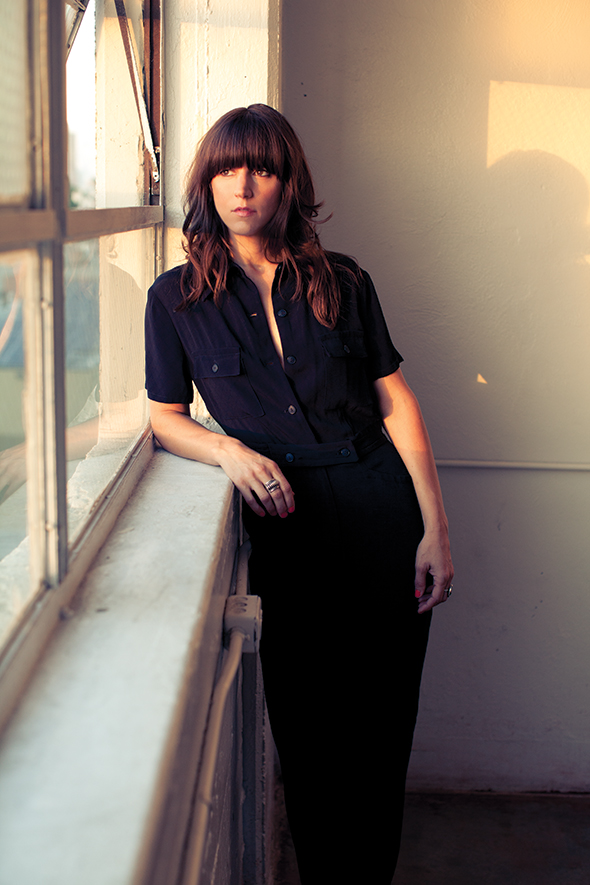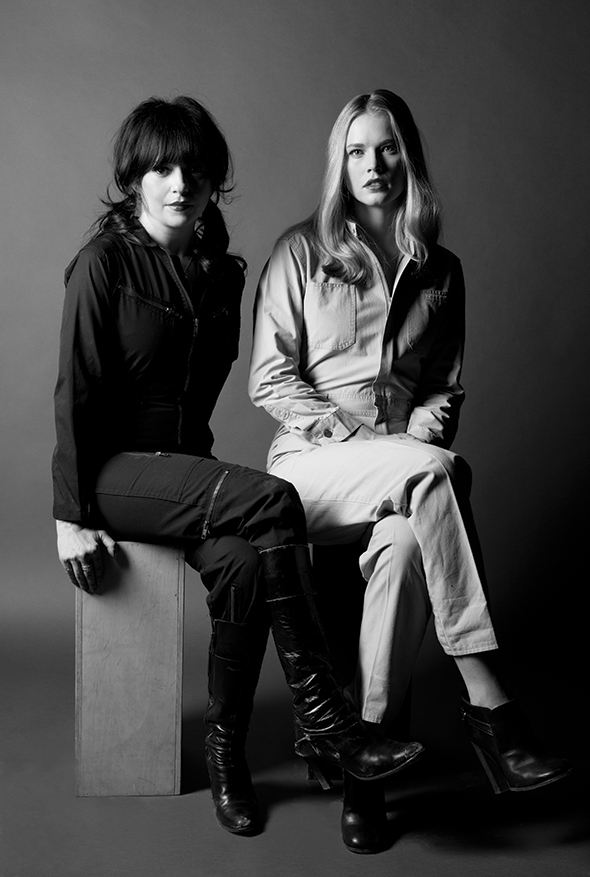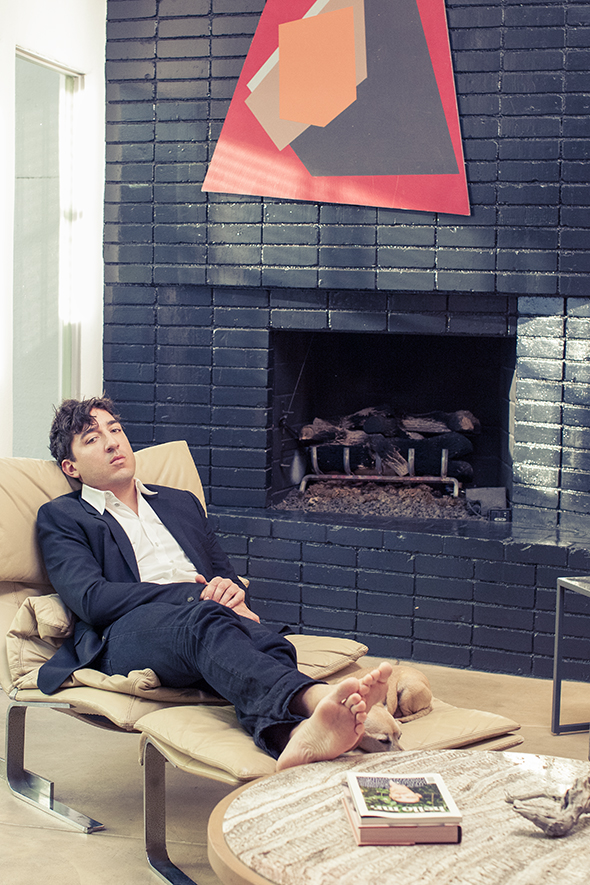Eleanor Friedberger

At a time when most female singer-songwriters perform as alter egos, Eleanor Friedberger is simply, refreshingly herself. And that’s just the way her fans like it. Having spent the last decade fronting the indie-rock institution The Fiery Furnaces (currently on hiatus) with her brother Matthew, in 2011 she emerged as a formidable solo artist with Last Summer, a thoughtfully crafted tale of memory and place couched in the organic pop of her ’70s idols. Instantly, Friedberger established herself as a modern-day heir to the tradition of Donovan, Todd Rundgren, Ronnie Lane, and their ilk – those known for warm, nuanced, timeless songs. No gimmicks necessary.
The title of Friedberger’s sophomore album is Personal Record, and it is, in a sense. Personal, that is. But it’s not personal in the way of, say, a coming-of-age record or a diary about the past, as Last Summer is. Many of the songs seem to be about love, or love lost, but whether any of the experience is hers or someone else’s, she isn’t saying. “It’s not as specific a narrative this time,” she says. “There’s a universality to it.” So incisive are the lyrics, in fact, that Friedberger’s bassist incorrectly assumed that two of the songs were about him. “I loved that,” she says. “I want him to feel like the songs are about him. I want you to feel like the songs are about you.”
The term “personal record” also refers to an athlete’s best, and the double entendre is apt. An intense decade-plus of touring and recording has burnished Friedberger’s voice and imbued her songwriting with newfound depth; there’s a maturity and mellifluousness to this outing that feels downright epic. It was always the Eleanor-penned songs that gave the Furnaces’ albums their most poignant and graceful moments, especially in later work like I’m Going Away. Last Summer took that promise into full flower; Personal Record “is part of the same growth process,” she says. Faced with a six-month gap between the completion of Last Summer and its release and accompanying tour, Friedberger holed up at home in Brooklyn. By the time the tour started, she had twelve new songs to road-test. Though most bands work this way, the Furnaces didn’t. For Friedberger, touring with the unreleased material allowed her to flesh out a more rollicking, full sound from the get-go. “By the time I came home,” she says, “I knew exactly what I wanted the songs to sound like.”
She reunited with Last Summer producer Eric Broucek (the DFA-trained emerging talent whose clients include !!!, Hercules and Love Affair, and Jonny Pierce) to expand upon the warm, textured atmosphere of their first collaboration. Tracking began in fall 2012 with a week at Plantain Studios, the West Village home of DFA. To Friedberger’s favored electric pianos and classic-rock guitars, they added a menagerie that included an upright bass, an alto flute, a bass clarinet, and even a portative organ. (That’s a device made of several recorders and a bellows in a frame that looks like a wooden castle… or like Howl’s Moving Castle.)
Production then resumed at Broucek’s home studio in the Los Angeles hills, where the rest of the record was completed in just ten days. As the songs filled out, Friedberger went fullout in immersing herself in her romantic vision of that city. “I was just listening to Fleetwood Mac and Neil Young, driving around in a borrowed Prius,” she says. “Walking along Point Dume, playing tennis at Griffith Park… I ate hippie food every day. Lots of lentils.”
The sun-warmed languor of the West Coast and its golden age of rock’n roll shines through in Personal Record. It’s the aural equivalent of an afternoon jaunt up the PCH in an orange BMW 2002, fist pumping into the wind. “When I Knew” and “Stare at the Sun” rock out like the Furnaces’ finest, but with that unmistakable Eleanor gracefulness. “Echo or Encore” is a lilting love ballad underlaid with a bossa nova beat. “I Am the Past” evokes the mystical side of the Me Decade with meandering bass clarinet and a balls-out flute solo (seriously). Though Friedberger may harbor a bit of a ’70s fetish, there’s an idiosyncrasy and intimacy to her music that’s undeniably modern. Above all, it’s pretty. “It’s such a romantic album to me,” Friedberger says.
“But more so than love for another person, it’s really about a love of music.”
Photography: Darian Zahedi
Hair: Michael Quinn | Makeup: Heather Cvar | Stylist: Elizabeth Parks Kibbey | Photo Assisstant: Nik Massey
Death Valley Girls
Laura Kelsey, Bonnie Boomgarden

It’s easy to mistake Death Valley Girls for a biker gang. First of all, the members of this snarling garage rock quartet look like they jumped out from the pages of Karlheinz Weinberger’s Rebel Youth, a book that documents ‘50s and ‘60s juvenile gangs. At any one of their shows, a row of ratty, raked out choppers can be seen lined up in classic motorcycle club formation.
Even their names are reminiscent of vintage biker B-movies. Bonnie Bloomgarden is the leader of the pack. Peering out from a straight line of jet-black bangs is a bass player who just goes by
“Rocky”. Laura Kelsey (formerly of The Flytraps, a surf/garage girl band) plays Mo Tucker meets Nick Knox-style drums and
Larry Schemel, who played in the last incarnation of legendary L.A. punk pagans The Flesh Eaters, plays fuzz-heavy guitar and sounds like he could be the bastard son of Davie Allan.
Speaking of the guitar, you’d be hard-pressed to find a meaner opening riff for “No Reason”, the most menacing song from Street Venom, DVG’s debut album. It sounds like Larry plugged his guitar straight into a hornet hive and then kicked it. When the rhythm section joins in it gives the song a sinister kind of rumble that would make Link Wray proud. Bloomgarden’s snotty, bratty vocal sneer cements their sound with old-school girl gang attitude.
Photography: Darian Zahedi
Hair: Whitney Thomas | Makeup: Heather Cvar | Stylist: Elizabeth Parks Kibbey | Photo Assisstant: Nik Massey
Nicole Simone
Although she was born in the ’80s, Nicole Simone has always been fascinated with nostalgia and old films. When she writes music, she particularly loves creating a mood that transports listeners to vintage-like movie scenes. Simone says that she is influenced by “music I hear, paintings I see, and architecture I’m surrounded by, but I am always drawn to classic and timeless pieces with unique details.” With such sultry songs as “Melt”,
Simone pairs breathy bits of voice, guitar, piano and muted trumpet with images of her curvy and flirtatious, for-your-eyes only kind of a dance that begins in a desert and makes its way to a motel room encounter. Simone strikes the kind of slinky tone that is reminisccent of Chris Isaak’s famously provocative video,
“Wicked Games”.
Photography: Darian Zahedi
Ed Droste
Grizzly Bear

Last year, IBM released a report about the way marketing officials at major corporations are using the Internet. Though the gist of the study concluded that these high-paid administrators weren’t using it very well, the October release actually hinged on a much more intriguing and intimidating fact: “Every day we create 2.5 quintillion bytes of data—so much that 90 percent of the world’s data today has been created in the last two years alone.”
We simply can’t keep up. Whether it’s the deluge of mp3s that flood the Internet daily, the information that companies collect about the purchases we make, or the photos of family pets and weekend meals our friends load onto social networks, the worldwide swell of data is best managed by supercomputers and servers, not the people who, in essence, manufacture and depend upon it. It’s hard to resist the temptation of this ever-accelerating cycle to create and release quickly so that the world’s bytes don’t leave you behind.
But Shields, the fourth and most fluid album by Grizzly Bear to date, slyly defies that trend. True, the quartet of Chris Bear, Ed Droste, Daniel Rossen and Chris Taylor have never made a quick follow-up; it took them three years to get from Horn of Plenty to Yellow House and three more to get from Yellow House to Veckatimest. Between those records, though, they toured and issued singles and splits, EPs and remixes. After long spans of shows for Veckatimest, however, Grizzly Bear went silent while its members went about living their own lives. Trips were taken and friendships were restored, families were visited, and solo projects were finished. The energy that had gathered over years in tour vans and busses, in studios and on stages was finally released, giving the individual band’s pieces the chance to recover and, after a year, return to being Grizzly Bear.
The quartet first reconvened last summer in Marfa, Texas, with the loose plan of rehearsing and demoing new material to see where potential songs for the next album stood. Almost nothing stuck, but that was fine. In Texas, they were reconnecting as friends and musicians, and the material would surely come. Against the inclination of the digital world, they took their time.
“Clearly everyone had been in a very different space,” says Rossen, “so most of the Marfa time was seeing each other again, trying things and feeling each other out. We all had to meet each other again.”
When they reconvened in January, again at the immortalized Yellow House in Cape Cod, they were anxious to return to Grizzly Bear. Indeed, Shields depends on the urgency of a band whose members have opted back in. For the first time, Rossen and Droste wrote songs together, taking each other’s ideas and extending them—ultimately executing them with a new vitality. They wrote more songs than they needed to, edited scrupulously and moved forward only with the songs that were most open to true quartet collaboration. Asked which tunes on Shields belong to which songwriter, every member balks and explains that, for the first time, these are actually full-band numbers. Both in process and product, this is Grizzly Bear as they’ve never been.
“Sun in Your Eyes”, the seven-minute close to Shields, stemmed from a piano melody Droste wrote and discarded but that Rossen picked up as a pet project and spent weeks building, changing and rebuilding. The result is one of the most brilliant and audacious pieces of Grizzly Bear’s oeuvre, dependent upon the same mix of drive and drift that shapes the bulk of Shields. Though soft at the edges, “Yet Again” pushes toward the status of rock anthem, with a bridge that refracts dance beats through a musical kaleidoscope; the slow creep of “What’s Wrong” commands an answer, its antiphonal vocals and anxious strings giving voice to a frown and a sigh. Those open emotions are an integral part of Shields, the most cohesively written album of Grizzly Bear’s career. The words come matched by a sound that is more passionate than proper, a quality earned by spending less time on the perfect take than on capturing feeling.
“This has a different energy behind it,” concludes Droste. “Veckatimest was a little more of a polite album; the desire to keep the vocals smooth might have kept a little distance between us and the audience. This one feels a bit more rough and exposed, so that on Shields, everything speaks for itself.”
Text By Grayson Currin
Photography: Darian Zahedi
Hair and makeup: Heather Cvar


